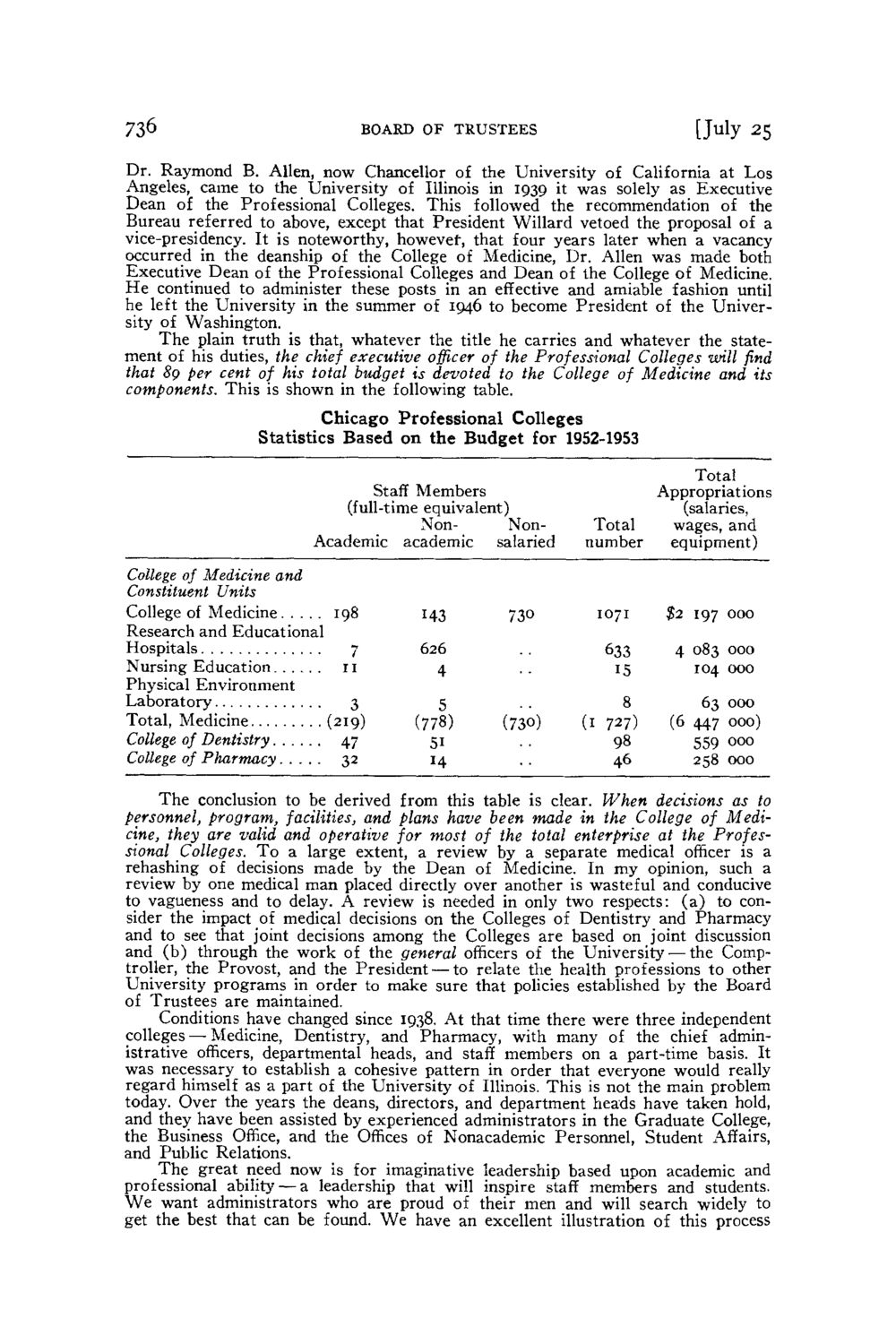| |
| |
Caption: Board of Trustees Minutes - 1954
This is a reduced-resolution page image for fast online browsing.

EXTRACTED TEXT FROM PAGE:
736 BOARD OF TRUSTEES [July 25 Dr. Raymond B. Allen, now Chancellor of the University of California at Los Angeles, came to the University of Illinois in 1939 it was solely as Executive Dean of the Professional Colleges. This followed the recommendation of the Bureau referred to above, except that President Willard vetoed the proposal of a vice-presidency. It is noteworthy, however, that four years later when a vacancy occurred in the deanship of the College of Medicine, Dr. Allen was made both Executive Dean of the Professional Colleges and Dean of the College of Medicine. H e continued to administer these posts in an effective and amiable fashion until he left the University in the summer of 1946 to become President of the University of Washington. The plain truth is that, whatever the title he carries and whatever the statement of his duties, the chief executive officer of the Professional Colleges will find that 89 per cent of his total budget is devoted to the College of Medicine and its components. This is shown in the following table. Chicago Professional Colleges Statistics Based on the Budget for 1952-1953 Staff Members (full-time equivalent) NonNonAcademic academic salaried College of Medicine and Constituent Units College of Medicine 198 Research and Educational Hospitals 7 Nursing Education 11 Physical Environment Laboratory 3 Total, Medicine (219) College of Dentistry 47 College of Pharmacy 32 Total Appropriations (salaries, wages, and equipment) Total number 143 626 4 5 (778) 51 14 730 .. .. .. (730) .. .. 1071 633 15 8 (1 727) 98 46 $2 197 000 4 083 000 104 000 63 000 (6447000) 559 000 258 000 The conclusion to be derived from this table is clear. When decisions as to personnel, program, facilities, and plans have been made in the College of Medicine, they are valid and operative for most of the total enterprise at the Professional Colleges. T o a large extent, a review by a separate medical officer is a rehashing of decisions made by the Dean of Medicine. In my opinion, such a review by one medical man placed directly over another is wasteful and conducive to vagueness and to delay. A review is needed in only two respects: ( a ) to consider the impact of medical decisions on the Colleges of Dentistry and Pharmacy and to see that joint decisions among the Colleges are based on joint discussion and (b) through the work of the general officers of the University — the Comptroller, the Provost, and the President — to relate the health professions to other University programs in order to make sure that policies established by the Board of Trustees are maintained. Conditions have changed since 1938. At that time there were three independent colleges — Medicine, Dentistry, and Pharmacy, with many of the chief administrative officers, departmental heads, and staff members on a part-time basis. It was necessary to establish a cohesive pattern in order that everyone would really regard himself as a part of the University of Illinois. This is not the main problem today. Over the years the deans, directors, and department heads have taken hold, and they have been assisted by experienced administrators in the Graduate College, the Business Office, and the Offices of Nonacademic Personnel, Student Affairs, and Public Relations. The great need now is for imaginative leadership based upon academic and professional ability — a leadership that will inspire staff members and students. W e want administrators who are proud of their men and will search widely to get the best that can be found. We have an excellent illustration of this process
| |